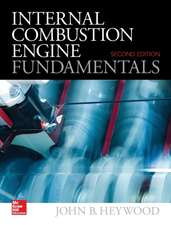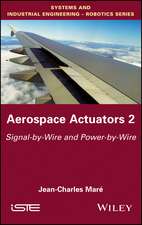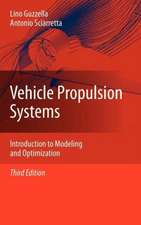Nonlinearity in Structural Dynamics: Detection, Identification and Modelling
Autor K Worden, G.R Tomlinsonen Limba Engleză Hardback – 7 dec 2000
Preț: 1421.84 lei
Preț vechi: 1979.66 lei
-28% Nou
272.11€ • 283.03$ • 224.64£
Carte tipărită la comandă
Livrare economică 14-28 aprilie
Specificații
ISBN-10: 0750303565
Pagini: 680
Ilustrații: illustrations
Dimensiuni: 156 x 234 x 43 mm
Greutate: 1.42 kg
Ediția:1
Editura: CRC Press
Colecția CRC Press
Public țintă
ProfessionalCuprins
Summary chapter and guidelines on nonlinear procedures: Flow diagrams. Why not dynamical systems theory. Summary of linear system theory: Continuous-time. Discrete-time. Dynamic testing of linear and nonlinear structures: Simple procedures for detecting nonlinearity in dynamic testing. Sine, Chirp, Random, Impulse etc. Linearisation. Correlations-coherence. FRFs of linear and nonlinear systems: Harmonic balance. Averaging methods. Nyquist plots. Carpet plots. MDOF systems. Hilbert transform - a practical approach: Definition in terms of odd/even functions. Time-frequency domain definitions. Computation - fast method. Correction terms. Principal component analysis. Corehence. Damping estimation (Khalid's work). Linearisation from random testing. Spectral moments. Hilbert transform - a complex analytical approach: Contour integrals. Titchmarsh's theorem. Artificial noncausality. Correction for asymptotic behaviour. Viscous v. Hysteretic damping - exponential integrals. Pole-zero decomposition - estimation without truncation. Restoring force surfaces and direct parameter estimation: Masri/Caughey theory. Link models/Khalids approach. Application requirements - integration/differentiation of data. Least-squares estimation: Normal equations. Orthogonal estimator. SVD. Recursive LS. - forgetting factors. Discrete-time methods: NARMAX. AVD. Model validity. Functional series: Volterra series. Existence, uniqueness, convergence. Connection with Green's functions - calculation - symmetries. Fliess/Lamnabhi power series approach. Wiener series - high-dimensional correlations - Volterra limit. Higher order FRFs/Transfer functions: Harmonic probing. Interpretaton. SDOF/MDOF systems. Hypercurve fitting (S. Gifford). Convergence revisited (Dr Lee). Neural networks: Multi-layer perceptrons. Radial basis functions. Modelling nonlinear systems. Dynamics neurons. Networks as nonlinear dynamical systems. Classification of nonlinear systems: Pattern recognition/feature extraction. Wigner-Ville distribution. Wavelet transform. Neural networks. FRFs for classification SDOF/MDOF. Nonlinear least-squares: Piecewise-linear systems. Hysteretic systems. Yar/Hammond - GA parameter estimation. Gradient descent - shock absorber model.
Recenzii
-R. Singh, Ohio State University
Descriere
Many types of engineering structures exhibit nonlinear behavior under real operating conditions. Sometimes the unpredicted nonlinear behavior of a system results in catastrophic failure. In civil engineering, grandstands at sporting events and concerts may be prone to nonlinear oscillations due to looseness of joints, friction, and crowd movements. In the aerospace industry, nonlinear motions may have serious implications for fatigue life. In the automotive industry, examples include brake sequel and undesirable engine mounting oscillations. Engineers of all types encounter nonlinear behavior in a system at some time in their working lives and should be able to recognize it.
Nonlinearity in Structural Dynamics: Detection, Identification and Modeling provides a background in techniques that can be applied to situations in which nonlinearity plays, or is suspected to play, a role in the dynamic structural behavior. Striking a good balance between theory and application, the book covers both analytical and experimental methods and describes their application to real structures. The authors include numerous examples of nonlinearity in real engineering systems. The book is essential reading for engineers and scientists in the fields of structural dynamics and nonlinearity as well as a useful supplement for graduate and senior undergraduate students in engineering courses.
























